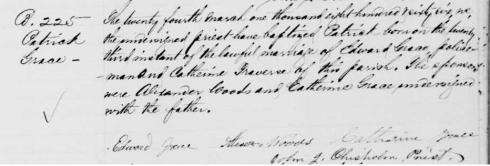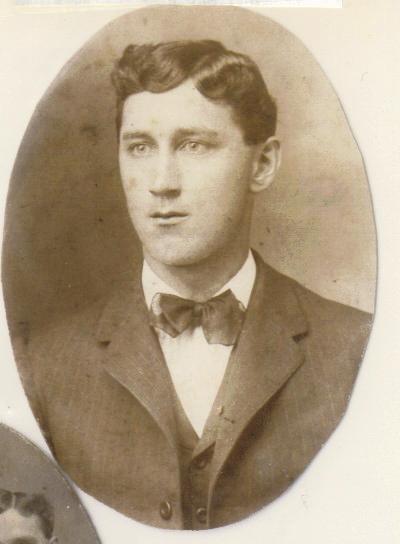My ancestors have a firm hold on my imagination. I gather small facts, or those stories which seem to be fact, and store them away, creating fiction to fill the gaps in what might have been the stories of their lives.
I keep coming back to this particular photograph. In my imagination it captures a moment in time that would soon slip from the grasp of not only my great-grandfather, but of an entire nation.
My great-grandfather was a professor of the natural sciences at the Baltimore City College in Maryland. Last year I found a copy of the 1925 issue of the City College year book, The Green Bag, and my father spotted this picture of his grandfather.
So here is that snapshot in time. Serious boys and serious professors, with one man quite out of place:

If I could thank G-G Haseltine, I would, for giving this gift to his progeny. Instead of the pat smile found in other photos, in which you have to strain to imagine something personal behind the facade, he has given us this; a glimpse of his humor and kindness.
Here he is in his element at City College, in a space affectionately called, “Hazy’s Hothouse”:

In 1925 The White House was occupied by another Vermont native, President Calvin Coolidge. The economy was transitioning into an era of mass consumerism. By the end of the decade 40% of the population would own their own automobile, and radio waves were reaching even the most isolated of rural Americans.
It was the era of decadence and of the celebration of masculinity; with some of the most popular American authors of the time being Fitzgerald, Hemmingway, and Faulkner. The Great Gatsby, with its critique of the American dream, was published in 1925, the same year these photographs were taken.
The year 1925 saw Darwin put on trial in Tennessee, defended by the agnostic super-lawyer, Clarence Darrow. I’m quite certain that it was this that led to the following tongue-in-cheek statement written by the City College Natural Science Club, pictured in the photograph with the skeleton: “At our first meeting Dr. Leslie H. Ingham, head of the Science Department, gave us a wonderful lecture on “Science and its Relation to the Bible.” Those of us who were present can testify as to the worth and educational value of this lecture.”
On a personal front, some miracles were happening in Baltimore. My great-grandparents were to be blessed with the birth of their fourth child, my grandmother, Marian. It had been more than eight years since their last child had been born, and Anna had passed her 40th birthday. I have to imagine they were surprised to find out they were expecting.
Yet I keep returning in my mind’s eye, to this snap shot in time, of Robert I. Haseltine sitting stoically with the skeleton and his other colleague, Leslie Ingham. In my fiction these few years must have been some of the happiest in his life. But it isn’t the happiness that draws me back to gaze into the photographs, it’s the fast transition that his life would take, a sharp contrast to the humor we see in this old black and white.
Around the time of this photo, the family homestead in Vermont would burn to the ground. Through WWI and up into the twenties, Robert and his wife Anna, along with their young children, were calling this place home, at least occassionally. This would have been the home where my G-grandfather was born, along with his father, and his father’s father.
This must have been the reason Robert’s father, Holden Haseltine, moved to Baltimore to live with his oldest son. Not long after, Holden would pass away in that city, in July of 1928.
I do not know when my great-grandmother, Anna (Lewis) Haseltine, was diagnosed with multiple sclerosis, or how serious the condition was. What I do know is that by the end of the year 1930, my great-grandfather would surrender his employment with City College, and permanently return to the family lands in Moretown, Vermont. There he would take care of his four children, my grandmother being just a young child, and in September of 1933, he would lose his wife to breast cancer. She was only 49 years old.
In that same year, Adolph Hitler would become the Chancellor of Germany, bringing the Nazi party into official power, and bringing the world head-long toward a terrible war.
The year also sees the inauguration of FDR, an unemployment rate of over 24%, and a top tax rate of 63%.
This is why I keep coming back to the photo. Time stands still there, in the library of Baltimore City College. Time stands still in that light-hearted moment, seemingly just before the world falls apart. In the following eight years RIH would lose his home, his father, his job, and his wife. He would see his children lose their mother. He would see his country fall into the depths of the worst depression in its history.
As he watched Hitler rise to power, how long was it before he wondered if he would have to send his own young son to fight this rising evil? Could he imagine that loss that was still 11 years in the future?
Some part of me would like to stop time at the place it was when that photograph was taken with the skeleton. Could we stop, go back, and fix what was about to happen?
The shadow of loss is cast on all of us in this life, but some lose more than others. In what ways do such losses leave an indelible mark even on the generations that possess no memory of the actual events? In what ways has it shaped or even created us as a family?

My father was only 5 years old when his grandfather passed away on November 20, 1955, in the 70th year of his life. Our grandfathers and great-grandfathers do shape us none-the-less, even for not having known them, or having known them only a little. For that I will one day have to thank Robert I. Haseltine Sr.

Census Links
Other sources: http://memory.loc.gov/ammem/coolhtml/coolhome.html; http://www.hyperhistory.com/online_n2/connections_n2/great_depression.html; http://fcit.usf.edu/HOLOCAUST/TIMELINE/nazirise.HTM
 The tombstone reads: Infant, son of E. (Ebenezer) & L. (Lydia) Haseltine. Died Jan 23, 1862, age 27 days. He is buried in the Haseltine or Fairmont Cemetery, just outside of Waterbury Vermont.
The tombstone reads: Infant, son of E. (Ebenezer) & L. (Lydia) Haseltine. Died Jan 23, 1862, age 27 days. He is buried in the Haseltine or Fairmont Cemetery, just outside of Waterbury Vermont.










